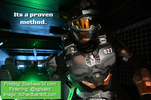FerventToast303
New Member
So I wanna try making an armor for a con I have in April. I wanna make a Mark VI or Mjolnir armor with maybe an Energy Sword or a MA40 rifle. I just...have no idea how. This would be my first ever build and don't know anything. I understand at the minimum that I need 2mm EVA foam and need to seal it with a heat gun and something else. I just have no idea what I do. I don't know how I would model it, how I cut the foam, all of that. I could really use help as I am very passionate about this and very excited. Thank you for the help, it is *greatly* appreciated.


